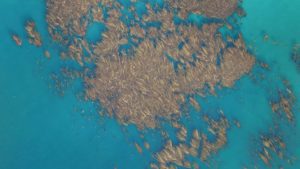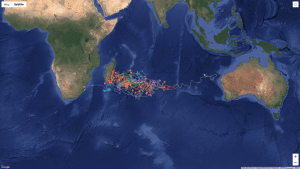UMass Dartmouth Internship Program

Thank you for your interest in the program! The application for Winter/Spring 2026 is now closed.
We are offering a paid research opportunity for UMass Dartmouth undergraduate students with the Woods Hole Oceanographic Institution (WHOI) January-April, 2026. Preference will be given to students who have not had an off-campus research experience in the past. Students will participate in a short course in January and begin a research project to be co-advised by a WHOI scientist and UMass Dartmouth faculty member through the spring semester.
Interns will be on-site full-time at WHOI in Woods Hole, MA, January 5-16 (weekend excluded) and March 16-20, 2026. WHOI campus housing is provided at no charge (travel allowance available if students prefer to commute). A stipend of $680/week is provided for the 3 weeks at WHOI. UMassD on-campus research throughout the semester is anticipated to continue at ~6-10 hours/week.
The research project will introduce undergraduate interns to types of research career opportunities that exist locally, and it may serve as a stepping stone for them to consider graduate studies. Research project options for Winter/Spring 2026 are listed below.
The short course will be 2 hours/day, Tues-Fri, Jan 6-9 and 13-16, including lectures and hands-on activities related to WHOI research on Blue Economy topics such as ocean aquaculture, offshore wind energy, harmful algal blooms, engineering and sensor development, and degradation of organic pollutants. The course will be taught in the WHOI DeepTech facility.
The application for Winter/Spring 2026 is now closed.
1. On-line Application Form - includes contact and academic information, and short answer questions about your educational/career goals and research interests
2. Unofficial Transcript - email to education@whoi.edu
3. Resume (pdf or doc) - email to education@whoi.edu
4. One Reference is required from a professor/instructor who knows you in an academic capacity. A second reference is optional from a job supervisor, another instructor, or another supervisor.
Instructions to send to reference letter writers are here.
Applicants will be notified of decisions by Dec 12, 2025. If you have any questions about the program or the application, please contact education@whoi.edu
Below are research project options for UMass Dartmouth interns for Winter/Spring 2026:
Marine Foundation Species: Development of algorithms for satellite imagery
Tom Bell (WHOI) and Yuchou Chang (UMASSD)
Read more

Giant kelp canopy showing fronds with varying physiological condition. Lighter colored senescent fronds contain less chlorophyll pigment and are generally older than darker frond with higher chlorophyll content. (Tom Bell, © Woods Hole Oceanographic Institution)
Marine foundation species (e.g., kelp forests, coral reefs, seagrass meadows, saltmarshes) structure entire communities, which are often ecologically and economically important, by creating physical habitat and enhancing productivity. Fundamental and applied research that quantifies how a changing environment interacts with marine foundation species can lead to a greater understanding of ecology and promote beneficial human outcomes.
The Bell lab at WHOI (Applied Ocean Physics and Engineering Dept.) focuses its research on macroalgae (kelp forests and Sargassum), salt marshes, and coral reefs and is motivated by understanding how the physical environment and intrinsic biotic factors drive the population and physiological dynamics of foundation species over local to global scales.
We are seeking a student interested in pursuing a research project focused on one of the following areas:
1. Development of novel algorithms to determine kelp biomass from satellite imagery. The student will combine field measurements, high resolution drone imagery, and satellite imagery to understand the standing biomass and turnover of bull kelp in Northern California and the Pacific Northwest.
2. Understanding the drivers of the physiological condition of Sargassum macroalgae in the tropical Atlantic. The student will derive a spectral algorithm from field and laboratory spectral measurements and apply this to hyperspectral imagery collected by a new NASA Ocean Color satellite.
Ocean Circulation: Using Drifters to Understand the Surface Circulation around Madagascar
Viviane Menezes and Heather Furey (WHOI) and Amit Tandon (UMASSD)
Read more

Spaghetti map of the 50 surface drifter trajectories for floats deployed at East Madagascar Current (Nov 28-Dec 11, 2024) and South Indian Countercurrent (May 2023)
The system of ocean currents that forms the global circulation plays a central role in regulating Earth's climate. One of the least understood parts of this system is the circulation near the southern tip of Madagascar in the South Indian Ocean. The East Madagascar Current, flowing southward on the eastern side of Madagascar, is in many ways a typical western boundary current, such as the Gulf Stream. However, the East Madagascar Current, as it flows along an island, runs out of the boundary at a relatively low latitude (25.5°S). What happens when this vigorous current detaches from the southern tip of Madagascar is still a mystery, debated in the literature since the 1970s. Some argue that the East Madagascar Current breaks up into mesoscale eddies that travel west and join the Agulhas Current, whose pinched-off rings and filaments drift into the Atlantic Ocean; others argue that the East Madagascar Current retroflects eastward to the South Indian Countercurrent, which flows to Australia; while others contend that both pathways exist, but the retroflection is restricted to the surface.
We now have a rare opportunity to disentangle these patterns by examining the trajectories of 50 surface drifters we deployed in the region in May 2023 and December 2024 as part of the East Madagascar Current Experiment.
We are seeking a student interested in statistically analyzing this unique drifter dataset and contributing to elucidating this long-standing mystery. Students will receive training in analyzing surface drifter trajectories and ancillary data from satellites. Desired skills include some coding experience (e.g., Matlab, Python, or other) or a willingness to learn coding, as well as a basic understanding of descriptive statistics (such as mean, standard deviation, etc.) and a background in STEM. Students can expect to learn about data analysis and data visualization, and gain insights into ocean circulation.
Spotlight on Assistant Scientist Viviane Vasconcellos de Menezes
Spotlight on Research Specialist Heather Furey
Researchgate profile: Vivian Menezes
Researchgate profile: Heather Furey
Benthic Ecology: Deep-Sea Hydrothermal Vents
Lauren Mullineaux (WHOI) and TBD (UMASSD)
Read more
The intern will have an opportunity to join a research project on deep-sea hydrothermal vents, learning skills in invertebrate taxonomy, benthic community analysis, and data science. We can customize the project to suit the interests of the students, working either on active vents (investigating recovery of the vent community after the April 2025 eruption) or on inactive vents (quantifying associations between species and their habitat in a newly discovered community on inactive sulfide features).
Seismic imaging of magmatic plumbing systems of volcanoes
Catherine Rychert (WHOI) and TBD (UMASSD)
Read more
In this project, the student will use earthquake data recorded by seismometers located near volcanoes to image the magma systems within and beneath the volcanoes. You will use novel techniques to image Earth structures and use state of the art experimental constraints to infer the properties of the Earth. You will constrain the locations where magma is ponding and/or determine the locations where magma related earthquakes are occurring, with the potential to enhance hazard mitigation efforts.
There are several promising possible targets for this research, including, for instance, Hawaii, Iceland, several submarine volcanoes, and many other locations, depending on the interest of the student. Computer programming background/experience is required. A math/physics/quantitative background is desired.
